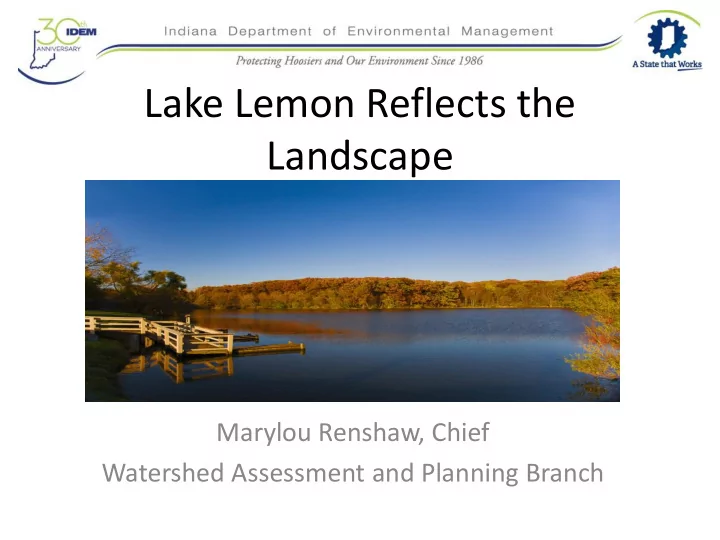

Lake Lemon Reflects the Landscape Marylou Renshaw, Chief Watershed Assessment and Planning Branch
What is a Watershed? • Watershed – Land area that drains to surface water – Surface water - rivers, streams, lakes, ponds, ditches
Water Pollution • Point source – Comes out of a pipe, such as industry or wastewater treatment plant effluent • Nonpoint source – Usually transported over land by storm water run- off or snow melt – Also includes pollutants that enter water from the air (e.g., mercury)
Nonpoint Source Pollution • Nonpoint source (NPS) pollution is greatest concern • Examples of NPS pollutants: – Nutrients (nitrates, phosphorus) – Sediment – E. coli – Pesticides – Fertilizers – Oil/grease
Sources of Pollution • Land disturbing activities • Run-off from row crops • Improper manure spreading • Livestock with direct access to streams • Leaking and failed septic systems • Stream bank erosion • Urban storm water run-off
Examples of Pollution Sources
Examples of Pollution Sources
Erosion Causes Problems in Waterways • Streams – Sediment from upstream erosion causes more erosion downstream – Damages macroinvertebrate and fish habitat – Degrades water quality • Lakes – Sediment fills lake, which loses depth – Temperature fluctuation increases – Dissolved oxygen may drop – Dredging is expensive and is a temporary solution – Preventing erosion upstream is a longer-term solution and more cost-effective
What Has Been Done to Improve Water Quality in the Bean Blossom Watershed? • Develop a watershed management plan – Upstream land uses affect downstream WQ – A unified plan ensures cost-effectiveness of on-the- ground practices • Implement best management practices – Conservation tillage – No-till adoption – Cover crop use – Fence livestock out of streams – Septic system maintenance
No-till
Cover Crop
Watershed Management Plan for Restoration and Protection of Bean Blossom Creek and Lake Lemon • Completed in 2008 www.idem.IN.gov/nps/3265.htm • Input from a diverse collection of stakeholders in the watershed • Water quality concerns inventoried • Pollutant sources and critical areas identified • Pollution reduction goals established
Implementation of Best Management Practices • Bean Blossom Watershed Management Plan Implemented from 2009-2012 – Reduced sediment entering the Bean Blossom watershed by roughly 27,200 tons per year – Reduced phosphorous entering the Bean Blossom watershed by more than 3,500 pounds per year – Reduced nitrogen entering the Bean Blossom watershed by roughly 8,600 pounds per year
Heavy Use Area Protection
Water and Sediment Control Overflow Basin
Stream Bank Restoration
Livestock Exclusion Fencing
What More Needs to be Done? • More implementation is needed – Target best management practices upstream – Expand implementation to more critical areas • Promote awareness – Increase awareness of water quality problems and what can be done to address them • Work with partners – Leverage skills, resources, and expertise
Partnerships Are Key • Industry and businesses • Urban and rural residents • Development community • County Surveyor • Agricultural producers • SWCDs • Plan commissions
Partnerships Are Key (cont.) • Health Departments • County Highway Department • Watershed and conservation groups/agencies • Municipal separate storm sewer system communities (MS4s) • Elected officials • Community leaders • Educators and students • Landowner groups
Funding is Available from the Indiana Nonpoint Source Program • Goal: To remove waterways from the 303(d) List of Impaired Waters • Program priorities include: – Watershed management planning in areas with waterways on 303(d) list – Implementing IDEM approved WMPs • Grants are available for planning and implementation
For more information contact your watershed specialist Josh Brosmer, Southwest Region (317)-308-3190 jbrosmer@idem.IN.gov
Questions?
Recommend
More recommend